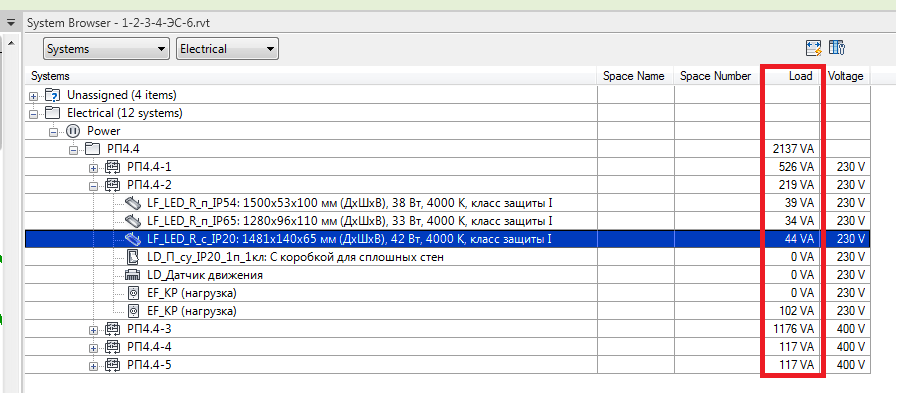
Today is my birthday, so I am trying hard to work less.
I am not completely successful, though, I'm afraid.
Very kindly, Alexander @aignatovich @CADBIMDeveloper Ignatovich, aka Александр Игнатович, provided us all with a gift for the day in the form of a new external command CmdElectricalLoad that he submitted to The Building Coder samples in pull request #12, saying:
I recently answered a question on the Russian ADN forum on how to retrieve the value from the
Loadcolumn in the electrical system browser for a specific fixture family instance, активная электрическая мощность элемента (in English, active electric power of an element):

Question: Tell me how to get the built-in parameter of the active power of an element in the category of electrical appliances OST_ElectricalFixtures.
RevitLookup provides information only on electrical circuits.
I am searching for the value of the power parameter, but it is not visible in the element.
If you go into ElectricalSystem, it starts working with circuits, and I need the power of the elements.
Answer: First, you need to get the necessary connector from the family related to the system of interest:
var mepConnectorInfo = connector.GetMEPConnectorInfo();
From that, we can get the value of the ParameterValue parameter:
var parameterValue
= ( DoubleParameterValue ) mepConnectorInfo
.GetConnectorParameterValue ( new ElementId (
BuiltInParameter . RBS_ELEC_APPARENT_LOAD ) );
And the final step:
var value = UnitUtils.ConvertFromInternalUnits(
parameterValue.Value, DisplayUnitType.DUT_WATTS );
Thank you very much, Alexander, for answering this important question and sharing the solution in such a useful form!
I edited Alexander's new command and added it to the text file BcSamples.txt for loading it using the Revit SDK RvtSamples application∫®.
Here is the resulting code, including Alexander's inimitable use of advanced .NET functionality enabling extremely succinct code:
[Transaction( TransactionMode.Manual )] public class CmdElectricalLoad : IExternalCommand { class ElectricalApparentLoad { public ElectricalApparentLoad( ElectricalSystemType electricalSystemType, int connectorId, double apparentLoad ) { ElectricalSystemType = electricalSystemType; ConnectorId = connectorId; ApparentLoad = apparentLoad; } public ElectricalSystemType ElectricalSystemType { get; } public int ConnectorId { get; } public double ApparentLoad { get; } public override string ToString() => $"{ElectricalSystemType}: {ConnectorId} " + "- {ApparentLoad} V*A"; } class ElectricalApparentLoadFactory { public IEnumerable<ElectricalApparentLoad> Create( FamilyInstance familyInstance ) { return familyInstance.MEPModel .ConnectorManager .Connectors .Cast<Connector>() .Select( Create ) .Where( x => x != null ); } private static ElectricalApparentLoad Create( Connector connector ) { if( connector.Domain != Domain.DomainElectrical ) return null; var mepConnectorInfo = connector.GetMEPConnectorInfo() as MEPFamilyConnectorInfo; var parameterValue = mepConnectorInfo ?.GetConnectorParameterValue( new ElementId( BuiltInParameter.RBS_ELEC_APPARENT_LOAD ) ) as DoubleParameterValue; if( parameterValue == null ) return null; var load = UnitUtils.ConvertFromInternalUnits( parameterValue.Value, DisplayUnitType.DUT_VOLT_AMPERES ); return new ElectricalApparentLoad( connector.ElectricalSystemType, connector.Id, load ); } } class FamilyInstanceWithApparentLoadSelectionFilter : ISelectionFilter { private readonly ElectricalApparentLoadFactory electricalApparentLoadFactory; public FamilyInstanceWithApparentLoadSelectionFilter( ElectricalApparentLoadFactory electricalApparentLoadFactory ) { this.electricalApparentLoadFactory = electricalApparentLoadFactory; } public bool AllowElement( Element elem ) { var familyInstance = elem as FamilyInstance; if( familyInstance == null ) return false; return electricalApparentLoadFactory .Create( familyInstance ) .Any(); } public bool AllowReference( Reference r, XYZ p ) => false; } public Result Execute( ExternalCommandData commandData, ref string message, ElementSet elements ) { var app = commandData.Application; var uidoc = app.ActiveUIDocument; var familyInstance = SelectFamilyInstanceWithApparentLoad( uidoc ); if( familyInstance == null ) return Result.Cancelled; var electricalApparentLoadFactory = new ElectricalApparentLoadFactory(); var apparentLoads = electricalApparentLoadFactory .Create( familyInstance ); TaskDialog.Show( "CmdElectricalLoad", string.Join( "\n", apparentLoads ) ); return Result.Succeeded; } private static FamilyInstance SelectFamilyInstanceWithApparentLoad( UIDocument uidoc ) { var electricalApparentLoadFactory = new ElectricalApparentLoadFactory(); var selectionFilter = new FamilyInstanceWithApparentLoadSelectionFilter( electricalApparentLoadFactory ); try { return (FamilyInstance) uidoc.Document.GetElement( uidoc.Selection.PickObject( ObjectType.Element, selectionFilter ) ); } catch( OperationCanceledException ) { return null; } } }